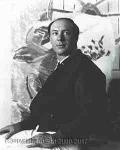Karl Knaths
Karl Knaths
Place: Eau Claire
Born: 1952
Death: 1971
Biography:
Karl Knaths was an American artist whose personal approach to the Cubist aesthetic led him to create paintings which, while abstract, contained readily identifiable subjects. In addition to the Cubist painters, his work shows influence by Paul Cézanne, Wassily Kandinsky, Utagawa Kuniyoshi, Paul Klee, Stuart Davis, and Agnes Weinrich. It is nonetheless, in use of heavy line, rendering of depth, disciplined treatment of color, and architecture of planes, distinctly his own.
Karl Knaths was born October 21, 1891, in Eau Claire, Wisconsin. His parents were Otto Julius Knaths and Maria Theresa Knaths. Shortly after Knaths's birth the family moved to Portage, Wisconsin where he spent his childhood years. When he was in his late teens his father died and he became apprenticed to his mother's brother, George Dietrich, in the baking trade. Although he had begun making sketches, he had no art instruction and little time for self-instruction. While attending Portage High School he met the local author, Zona Gale. She encouraged his interest and, upon his graduation in 1910, both convinced his uncle to release him from apprenticeship and introduced him to Dudley Crafts Watson of the Milwaukee Art Institute. During the next year he studied art at the Institute. He obtained the job by which he supported himself when Gale introduced him to Laura Sherry, the director of the Wisconsin Players. Despite his youth and inexperience, Sherry took him on as caretaker of the playhouse and one of its set designers. In 1911, on advice from Gale and Craft, Knaths began studies at the School of the Art Institute of Chicago. There, he mainly supported himself as janitor's assistant but when the 1913 Armory Show came to town he landed a job at the show as one of the guards. The show was his first substantial exposure to European modernism and he later reported that the experience both confused and awed him. Uncomfortable with most of the work on display, he found much to like in the works of Cézanne, particularly the blocks of muted color out of which he built his compositions.
In 1917 Knaths rejoined the Wisconsin Players as the group's scenery painter during a tour of East Coast theaters. When the Players arrived in Provincetown, Massachusetts for a performance of Gale's Mr. Pitt Knaths recognized it as a place where he could successfully practice his vocation. After two years' military service Knaths spent a short time studying art in New York City and then, in 1919, moved to Provincetown, which became his principal residence for the rest of his life. In the early twentieth century Provincetown was a prosperous fishing town which attracted artists and theater people from New York's Greenwich Village as summer residents. On or soon after his arrival he met two sisters, Helen and Agnes Weinrich of the Provincetown Printers. The sisters had grown up on a prosperous Iowa farm, daughters of German immigrant parents. When in their 20s they had accompanied their father on a trip to Germany where Helen studied music and Agnes painting. Their father dying, they received an inheritance which permitted them to live and travel on their own and they returned to Germany and France to study further. In 1914 the sisters began spending the warm months of the year in Provincetown and, through contact with European expatriates who settled there during World War I, Agnes learned to employ Modernist and particularly Cubist techniques in her work. After their first meeting Agnes helped Knaths to develop his personal style of painting and over time they developed a close and mutually beneficial working relationship. In 1922 Knaths married Helen and moved into the house which the sisters had rented. He was then 30, Helen 45, and Agnes 46. Agnes remained a member of the Knaths's household the rest of her life.
Knaths's earliest work has the strong lines, blocks of muted colors, and juxtaposition of rectangular and curvilinear forms which characterize his mature style. One of his early paintings, Horse Barns, Provincetown (1919, gouache, 7x8") contains three barn structures within a small grove of trees and bushes. It shows influence of Cézanne and is not notably Cubist. The coloration is low-key in green, purple, and ochre hues. The composition has sweeping rounded shapes beside heavily outlined rhombuses and other quadrilateral shapes. It has a painterly, nearly impressionist feel and, despite the subject matter, might as well be a still life as a landscape.
Knaths's mature style emerged in the early 1930s. It evolved, he said, as he "learned to move slowly from color relations, to line sequence, to better spacing, proportions, to a thematic play of shapes." During the 1920s he had studied, and sometimes translated from German, theoretical publications of theorists and artists, including Carl Einstein, Wilhelm Ostwald, Piet Mondrian, Wassily Kandinsky, and Jay Hambidge. He later reported that he was particularly impressed by ideas presented by Gino Severini in Du cubisme au classicisme; esthétique du compas et du nombre (Paris, J. Povolozky & Cie, 1921). While these books deal mainly with color, proportion, and Bauhaus design theory, Knaths was also interested in the relationship between music and painting and in this it is likely his wife, Helen, who was a conservatory-trained musician and whose piano playing he enjoyed almost daily, was an influence.
More...
Wikipedia link: Click Here














